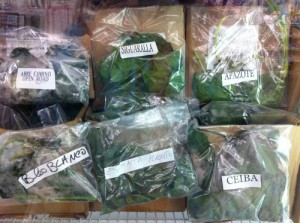Here’s a question for you: What do botany and healthcare have in common?
The answer is: Plants.

Traditional remedies. Photo courtesy of the author.
It is unlikely that a medical student today will be taught about William Withering, or foxglove, even though the same student will probably learn that digoxin is a cardiac glycoside medicine for heart failure. Just two hundred years ago, things were different. Physicians were also botanists, and the first botanical gardens were established by medical schools. Withering was one of those physician-botanists. He discovered the clinical potential of foxglove (botanical name: Digitalis purpurea L.) when he witnessed a patient with dropsy (edema) improve after taking a traditional herbal mixture that contained foxglove and other plants.
Since then, the paths of botany and medicine have diverged. Plant remedies are now part of what is called complementary and alternative medicine (CAM), an eclectic mix of diverse practices grouped together artificially because they are not considered part of mainstream medicine.
What Is Mainstream Medicine?
The World Health Organization has estimated that up to 80 percent of the people in developing countries use herbal remedies to meet their healthcare needs. Many of these communities do not have adequate access to biomedical care. One could argue that, for these communities, their cultural plant remedies are mainstream medicine.
The cultural use of plant remedies, often described as “traditional medicine,” is not restricted to remote rural areas where biomedical healthcare is lacking. In the past few decades, ethnobotany—the science that studies the relationships between people and plants—has ventured into urban areas, to investigate the use of medicinal plants by transnational migrants.
The term “traditional medicine” refers to the cultural roots of a community’s health beliefs and practices, passed down from one generation to the next. In this sense, “traditional” does not imply outdated or static. To the contrary: in a recent study we found that medicinal plant use by Dominican and other Caribbean communities is dynamic and responsive to the changing epidemiology of the environment.
Our survey of 175 first-generation immigrants from the Dominican Republic living in New York City demonstrated that medicinal plants were commonly used for chronic and lifestyle conditions, including diabetes, hypertension, asthma and cholesterol. These are prevalent health problems within that community.
It is not a coincidence that medicinal plant use follows this epidemiological pattern.
In New York City, poorly studied tropical plant remedies are commonly available in botánicas as unprocessed and dried plant material that can be purchased for a few dollars. Botánicas, shops that specialize in herbal remedies and spiritual items, cater to a diverse clientele of customers from the Caribbean and Latin America while operating as an invisible healthcare system running parallel to the biomedical system.
The Popularity of Traditional Remedies
When we asked Dominican study participants if they believed there were health conditions that biomedical healthcare providers do not understand or cannot cure, 79 percent of the 175 interviewees answered with a firm “Yes.”
The top ten conditions included several with a strong cultural component, such as culebrilla (herpes zoster), brujería (witchcraft), disipela (a skin infection), mal de ojo (evil eye) and empacho (gastrointestinal blockage). These culture-bound syndromes or folk illnesses are characterized by strong community-held beliefs about their symptoms and signs, causes and preferred treatments (the latter usually involving traditional medicine).
Significantly, patients reported that they do not communicate with their biomedical healthcare providers about these conditions or about the treatments they choose. Their faith in these remedies often supersedes their faith in biomedical treatments.
It is clear, then, that there exists a crucial gap in health communication between physicians and their Caribbean and Latino patients. That’s why in 2008, we started a Cultural Competency Training Program in Medicine at The New York Botanical Garden.
Learning About Botanicals and Cultures
The goal of this program is to promote culturally effective and sensitive healthcare. This involves care characterized by increased cross-cultural awareness; improved patient-provider communication; mutual understanding and respect for different cultural beliefs and practices; and increased trust from, and disclosure by, patients during clinical encounters.
So far, we have trained 740 medical students and practicing physicians in 49 individual training events. Many of our participants have been from Albert Einstein College of Medicine. Training activities include lectures, patient-interview exercises, role-playing exercises, classes in ethnomedical Spanish, guided botánica visits and tours of the living Caribbean plant collection at The New York Botanical Garden.
Bringing the patients and their cultural practices together with their future or current doctors is something ethnobotanists are uniquely poised to do. As scientists, we undertake original research that can be translated into curricular materials for medical training. Another part of our skill set is to provide botanical authentication for herbal remedies. Accurate botanical identification involves the collection, preparation and study of a herbarium specimen to identify its botanical (Latin) name. Doing this is a prerequisite for obtaining further information on the preclinical and clinical studies that underlie medicinal plant use. A virtual herbarium of our research with the Dominican community containing botanical identifications and plant pictures, many from botánicas, is available here and can be searched by plant common name or scientific name.
While some medical students and physicians may reject the use of these traditional medicines, these professionals must be aware of their potential use and be able and willing to discuss them with patients. Likewise, ethnobotanists can help doctors by identifying effective remedies that are being used by these patients. This is all the more important because research has shown that in an increasingly globalized and multicultural society, these culturally important remedies are likely here to stay.

